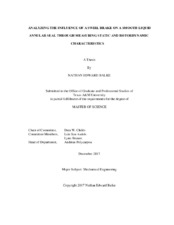Analyzing the Influence of a Swirl Brake on a Smooth Liquid Annular Seal Through Measuring Static and Rotordynamic Characteristics
Abstract
Data are available for a previously tested annular seal with no swirl brakes
(NSB). The NSB seal design was modified by adding slots at the inlet to produce a swirl
brake (SB) seal. Tests were conducted to evaluate the static and dynamic characteristics
of the modified SB seal. The SB data was then compared to the NSB data to understand
how the seal rotordynamic coefficients are affected when swirl brakes are added.
The SB and NSB seals had a radial clearance (Cr) of 203.2 um with the diameter
of the seals (D) being 102 mm. The length to diameter ratio (L/D) of the NSB seal was
0.50, while the SB seal had an L/D of 0.45 due to the addition of swirl brakes.
The SB seal was tested at three different inlet pre-swirl ratios (PSR): high preswirl, medium pre-swirl, and radial injection. During testing, operational conditions
were varied by changing differential pressure (?P), running speed (w), and eccentricity
ratio (e0). The test points were at w = 2, 4, 6, 8 krpm, ?P = 2.07, 4.14, 6.21, 8.27 bar
and e0 = 0.00, 0.27, 0.53, 0.80. The test fluid was ISO VG 2 oil.
The static data for SB showed that the flow rate (Q) increased as the imposed
PSR increased, meaning the high pre-swirl case produced the highest Q values. Swirl
brakes deliver the greatest reduction in PSR compared to that of NSB seals at high ?P,
low w, and toward the centered position (e0=0.00). A vector Reynolds number was
produced over the range of 1300 to 4400. The flow through the test stand was predicted
to be transitional and turbulent.
Subject
SealSeals
Swirl Brake
Centrifugal
Pump
Compressor
Turbine
Pressure Drop
Pre-Swirl
Circumferential Flow
Fluid Flow
Process Fluid
ESP
Electrical Submersible Pump
Stiffness
Damping
Virtual Mass
Rotordynamics
Dynamics
Static
Turbomachinery
Stator
Rotor
Effective Damping
Whirl Frequency Ratio
WFR
Outlet Swirl
OSR
Leakage
Eccentricity
Clearance
Citation
Balke, Nathan Edward (2017). Analyzing the Influence of a Swirl Brake on a Smooth Liquid Annular Seal Through Measuring Static and Rotordynamic Characteristics. Master's thesis, Texas A & M University. Available electronically from https : / /hdl .handle .net /1969 .1 /174654.


